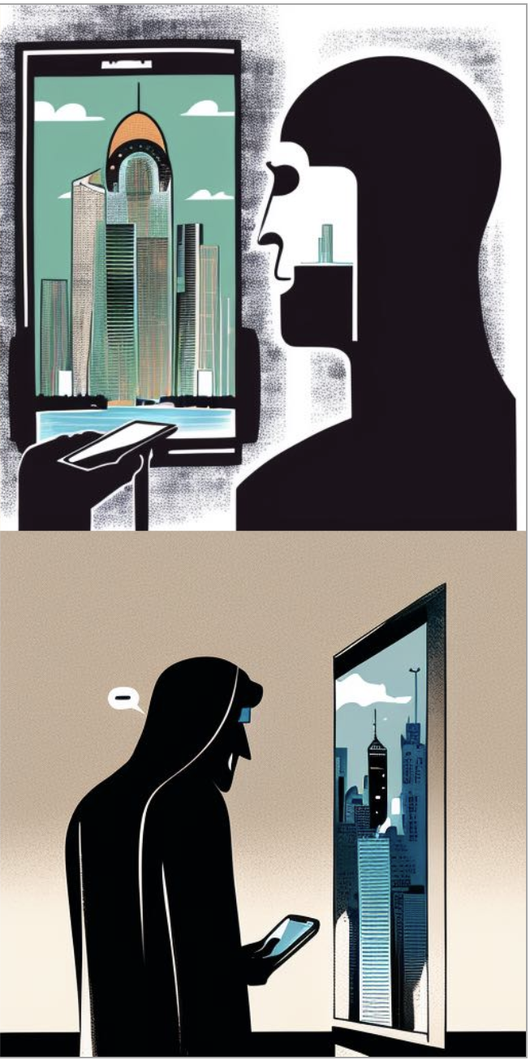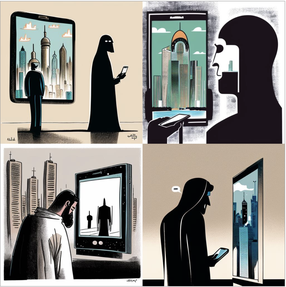In the waiting room of a government facility, I battled boredom by experimenting with a typing AI application, the ChatGPT app. I asked it to propose an idea for a political cartoon about AI and how it would change the world. I also insisted that the drawing be similar to the style of the cartoonist Khalid Albaih – me!
The answer was, as translated here:
The ChatGPT proposal was based on a theoretical analysis of all my works available on the internet. From this a decision was made based on statistics and algorithms that determined what Khalid Albaih would create in this context. I copied this proposal and pasted it into the Midjourney model, an AI model specialized in converting written text, beginning with the command ‘imagine’, into graphics. The model fulfilled my wish within a few seconds and presented four different works of art to choose from, all drawn in the style of Khaled Al Baih. Alternatively, I could re-enter the request many times until I reached what I needed. Midjourney will give you everything you want, with no tirelessness or creative fatigue, just as it will not reject you even once – either you will get bored of it or your internet subscription package will expire first.
The cartoons created by Midjourney followed a command generated by the ChatGPT form.
The results are not always satisfactory, but there is no doubt that they are impressive – even if most writers and artists, including myself, do not wish to admit it. We do not want to feed the ego of our new competitor. Instead, we cling to the claim that only we humans can breathe our soul into artworks that reflect our life experiences, unlike this automated model that summarizes our experiences with just a click, which is reflected in its cold digital creations in seconds and does not ask for a fee but rather asks whether you need more.
What happens behind the scenes in these seconds is that, when you ask for more, it is not an innovation out of nowhere, of course, but rather a complex process based on a huge volume of data and visual resources. Billions of images and graphics on the internet are cut, pasted and merged together, according to the details of the command. Whenever I explain details, this robot, or the interactive model based on AI, sails the vast oceans of the internet to capture all the available unencrypted information in order to produce works of art from graphics or video clips.
This data, on which these intelligent interactive models depend, is not stored in an archive at the bottom of a dark vault, guarded by the bureaucratic complex of a 70-year-old man who is determined not to give information to anyone, for fear that it will fall into the hands of someone who may benefit from it – God forbid! Rather, it is mostly open-sourced data. The interactive system quickly benefits from this data, increasing the amount of knowledge it has to use in the instantaneous creation of information upon the next request from the user.
The danger lies in the fact that most of those interested in technology have been anticipating AI since the development of computers in the mid-19th century. Hundreds of science-fictional novels and Hollywood films have been inspired by this scientific reality. One of the early films of this genre was The Terminator, whose story revolves around AI’s domination of the world and the ensuing fierce war and human resistance, until a robot is transferred back in time to kill the future commander of the human army before he is born. Perhaps the most famous film on this subject is The Matrix, which takes place in the aftermath of a war between humans and AI, which ended with the victory and supremacy of AI. Humans are used and produced as batteries, and they live in a virtual world that resembles our real life today. A similar, more recent film, Her features a man who falls in love with an intelligent app with a woman’s voice. The plot is almost identical to what is going on today – the reliance on AI – at least in quite a few advanced Western cities.
As for the Arab world, the lack of AI programs in Arabic at present has hindered the use of this technology on a larger scale. When these programs are developed in Arabic, a lot of people, especially students, will start relying on it to write research papers and assignments, similar to what other students already do today in English, to the extent that schools and universities have had to block the online access to the ChatGPT website on school premises. These models have previously been used by some political regimes, lobbyists and media propaganda online. Some extreme right-wing websites in the United States have adopted AI models to fabricate and publish defamatory reports about Qatar, Turkey, Iran and other countries. These reports are attributed to made-up personalities, even with accompanied AI-generated profile pictures. There are rising concerns about the danger of apps such as ChatGPT and others in misinformation campaigns on social media.
That said, it is no longer surprising that social media platforms are flooded with theories and articles that warn against AI models and applications and demonize them. There are those who see an imminent danger in facilitating users’ access to information freely, while others see it as a threat to humanity, one that could eventually replace human capabilities. I personally think that it is important to take advantage of all the available opportunities to use this technology in our societies and not to hesitate or delay conquering this field.
AI has a long way ahead to really gain control, especially in the Arab region: I wrote this article after I spent my morning watching an employee typing with only one finger on an ancient computer, and I am sitting here, in a chair that is about to break into pieces, in a government facility waiting area, with nearly a thousand people waiting for power to be restored in their houses.

